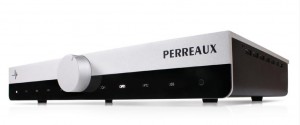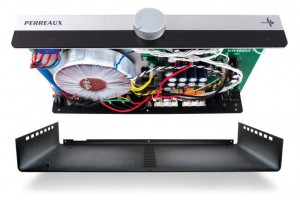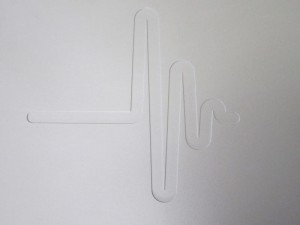$2999
4.5 stars
High end Kiwi hi-fi company make an affordable amp, but it’s hardly normal
 Hi-fi manufacturers aren’t exactly located on every corner here in NZ, but the few that are operating tend to be long stayers in the industry. Take Perreaux for instance: established way back in 1974 by Peter Perreaux, this modest company has been responsible for some of Kiwi audio’s greatest moments. They actually started off producing live PA system amplifiers but soon diversified into the home audio market with legendary products such as the SA80B integrated and the bomb-proof PMF2150 power amplifier.
Hi-fi manufacturers aren’t exactly located on every corner here in NZ, but the few that are operating tend to be long stayers in the industry. Take Perreaux for instance: established way back in 1974 by Peter Perreaux, this modest company has been responsible for some of Kiwi audio’s greatest moments. They actually started off producing live PA system amplifiers but soon diversified into the home audio market with legendary products such as the SA80B integrated and the bomb-proof PMF2150 power amplifier.
Legend has it that Peter Perreaux demonstrated the indestructibility of his product to stunned onlookers by hurling an amplifier off a building. It’s quite possibly one of the NZ audiophile scene’s urban legends, but certainly he created some mighty robust MOSFET equipped amplifiers back in the day.
Nowadays, Perreaux is headed by Martin Van Rooyen, and although things have become extremely sophisticated in terms of production and design, this iconic Kiwi audio manufacturer still uses the reliable MOSFET in its designs.
In recent years Perreaux have garnered acclaim for the still-superb Radiance R200i integrated, and the niche Silhouette range, yet probably the product that is most memorable for me is the E160i integrated amp. It was a no-nonsense 160w per channel stereo amp with good sound quality, robustly built and very compatible with the vast majority of sources and speakers.
Rumours
It was no surprise when rumours of a new Perreaux amplifier targeted at a lower price point started swirling around the hi-fi scene in NZ. After all, the diminutive Silhouette range was just too quirky to attract a mainstream following, and the next step up was the high-end Eloquence 150i – too pricey to attract the first time audiophile.
Thus the Audiant 80i was born to fill the gap between the ranges, and I had the honour of checking one out over a two-month period.
Controversy
Firstly though, I’d like to quell a storm in a teacup surrounding the Audiant 80i. Last year Perreaux entered into an agreement with Harvey Norman to supply their products exclusively, and the ‘word on the street’ was that Perreaux was commissioned by the megastore to design and build this amplifier for them. I have it on extremely good authority that the Audiant was on the design board a good two years or so before the Perreaux/HN relationship began, so this rumour is completely false. For starters, Perreaux has exported the Audiant 80i to various markets overseas, and it wouldn’t be such a great idea to ‘cobble’ an amplifier together in a rush and export it with potential risk to the reputation of the company.
That’s that out of the way then – now to the review proper.
Tech Stuff

I was greeted by a capacitive touch-screen dimmable panel on the bottom-front fascia for input selection, and a large centrally located volume knob. The thick top panel has the Audiant ‘wavelength’ logo milled into the surface, and this provided a clue as to the need for such a hefty slab of metal.
The top plate actually acts as the heatsink for the Audiant (reminiscent of the Musical Fidelity A1), and unlike just about every amplifier I have ever opened up the internal components are attached to this: think about your home for instance, and imagine all the furniture stuck to the ceiling – that’s how the Audiant is laid out internally.
Perreaux has had an eye to the future while designing the 80i. No fewer than four digital inputs are selectable from the touch screen panel (coax/2 x optical and USB) while they’ve thoughtfully included a very good MM phono stage and HT pass-through along with a third analogue input. The internal ESS-Sabre DAC will upsample redbook CD to 24/96 resolution, but the non-asynchronous USB input is limited to 24/48, a bit of an oversight considering the slavish obsession to specifications and numbers I have observed amongst computer audio-buffs.
Perreaux has rated the Audiant at a respectable 80wRMS per channel, and some of this output must be biased into Class-A as the top heatsink became quite warm during my listening sessions. Back panel connections are quite comprehensive as expected, with the brace of digital and single-ended inputs, while a decent set of binding posts are provided. It’s also where you’ll find the master on/off switch (the standby button is on the left front on the fascia) and the earthed IEC power socket will allow experiments with upmarket power cables if so desired.
It’s quite a hefty device at 11.5kg, but the slim profile means there is no bulk. I’ve read elsewhere that the Audiant resembles the Logitech Transporter (well, it kinda does), but this can only be a good thing for owners of this particular component as they look as if they were made for each other.
Equipment Used

Listening sessions were conducted in two systems with a constant stream of different components, system one being my TDL Studio 0.5’s/Pink Triangle LPT with Rega RB300 arm and Denon DL110 cartridge/Logitech Squeezebox Duet/Jungson Moon Harbour Tube CD player with Nordost SuperFlatline Mk2 speaker and Sonic Wind interconnects on my Serious Rack’s support, while system two comprised of Castle Harlech S2’s or my Voigt ‘Vofo’ single driver speakers, Moon 750D Dac/Transport (wow)/Squeezebox Touch and my Pro-Ject Studie turntable with a Sumiko Blue Point Special Evo3 cartridge. System support for was courtesy of my splendid Soul To Sole rack.
Yes, it looks a touch on the crazy side using all this gear, but I did ‘own’ the Audiant for quite some time and had a great time experimenting with it.
At Last: Sound Quality
With fading memories of the old E160i swirling around in my brain I was immediately aware just how different the Audiant sounded in comparison: where the older amp had a tendency to sound a touch on the brighter side of neutral when used with certain components, the Audiant sounded quite lush and melodious in both systems used. In fact, my old Musical Fidelity sprang to mind; it’s heavily biased into Class-A and was regarded as a warm sounding device.
Cynics could unfairly suggest the Audiant 80i as being ‘coloured’, but the reality was that I was able to sit down and listen for long periods without yawning or reaching for the off button. A case in point being my 24/96 vinyl rip of the Miles Davis/Gil Evans collaboration Miles Ahead – this sounded positively wonderful via the SB Touch (which outputs 24/96 natively) with very good presence, detail and soundstaging.
I had just purchased the wonderful Sea Change album by Beck from HDTracks.com (hi-res 24/88.2khz) so this had a number of plays via the coaxial input, and once again my listening room came alive with an involving listen – bass depth and definition was a particular delight with this recording, while Beck’s tortured vocal (it’s a breakup album after all) was nicely centred, with real body and texture.
I was impressed with the phono input of the Audiant, and although Perreaux claim it isn’t quite up to the standard of the Silhouette SXV2 it suited my Pink Triangle perfectly. Perennial favourite Memories Of Barber Mack by Ernest Ranglin proved to be a delightful listen using the first system, and the punchy low bass and sparkling keyboards/guitar combination had my big ol’ feet tapping away with every track played.

With all audio there are plusses and minuses, and an amplifier with a pronounced ‘warm’ sonic signature will probably lose out slightly in terms of speed and timing – what I‘d heard of the Audiant thus far into my listening appraisal was very good indeed in overall terms, but amplifiers from companies such as Naim or Linn exhibit better pace, rhythm and timing. Or so I thought, because it was time to haul the big ‘Vofo’s’ into the listening room. These use a single 8-inch Fostex FE206E full-range driver in a tall quarter wave cabinet and rank amongst the most dynamic, lightning quick speakers I have heard so far.
The Audiant suddenly took on a whole new persona: transients were startling on tracks from Tool’s Lateralus album, while basslines became tighter and faster. It was pretty yummy stuff, and all this extra drive and attack wasn’t at the expense of subtlety and involvement either.
Brickbat – or Bouquet?
At the end of my time with the Audiant I’d listened to just about every album I hold dear – either on CD, on the Squeezebox or on vinyl, and enjoyed them once or twice again via the Audiant. It’s unfair to compare the baby Perreaux with the likes of the much dearer Eloquence, but even though the Audiant is ‘only’ an 80w integrated it is capable of comparison with some pretty exalted competition – the sound quality is that good.
The only drawbacks for me were the lack of a true asynchronous 24/96kHz (or 192) USB input (even though the implementation here sounded very good indeed, I’m slowly being converted to computer audio fundamentalist status) and the bog standard ‘off the rack’ remote control. The visible screw attaching the volume knob didn’t turn me on either, but that’s really all that’s wrong with the Audiant 80i – it’s a superb amplifier and as such earns a strong Witchdoctor recommendation from this reviewer. GARY PEARCE
















Great to finally see a proper review of this amp. Will you guys be putting any more clips up on youtube regarding the Audiant?
Thanks Nathan, glad to see you enjoyed the review. The Audiant has been disconnected and packed up, ready for collection by Perreaux. Why don’t you pop down to a Harvey Norman branch for a looksie? It’s better in the flesh, believe me
Just when I thought I was “over” looking for another amp! Gary, would you say the Audiant was a conservative 80watts? Plenty of current?.
I quite like the looks also. I also hope the deal with Harvey Norman works well for Perreaux.
Yeah typical isn’t it Craig, just when you thought you were ‘safe’ along comes another serious contender. The Audiant had no trouble driving the very inefficient TDL’s (86dB) which suggests a decent current output, I reckon it’d suit your beaut B&W’s well. How would you break the news to the Mrs!!
Don the headgear then duck and weave!
Based on this and the other excellent reviews this amp has received, coupled with the fact that it perfectly fits my needs (DAC & Phono inputs in one easy-for-significant-other-to-operate package), I went ahead and bought myself one. I’ve spent the better part of the last 2 weeks locked to the sofa rediscovering my music collection. I’m extremely happy with it.
HI! A very interesting review… I’ve been looking for some information about this apm, unfortunately no one sell´s it here in sweden ;(.
Since this amp has exactly the things I’m looking for, I’m tempted to order one from New Zealand or the US. Except from this amp,the only other responsible amp that could suit my needs is the Rotel RA-12. However, when i listened to the rotel paired with my B&W cm1, it was not what I was expecting – I was not impressed.
So my question to you, before I make an Order, how do you think this amp will fit/suit together with a pair of B&w Cm1 ?